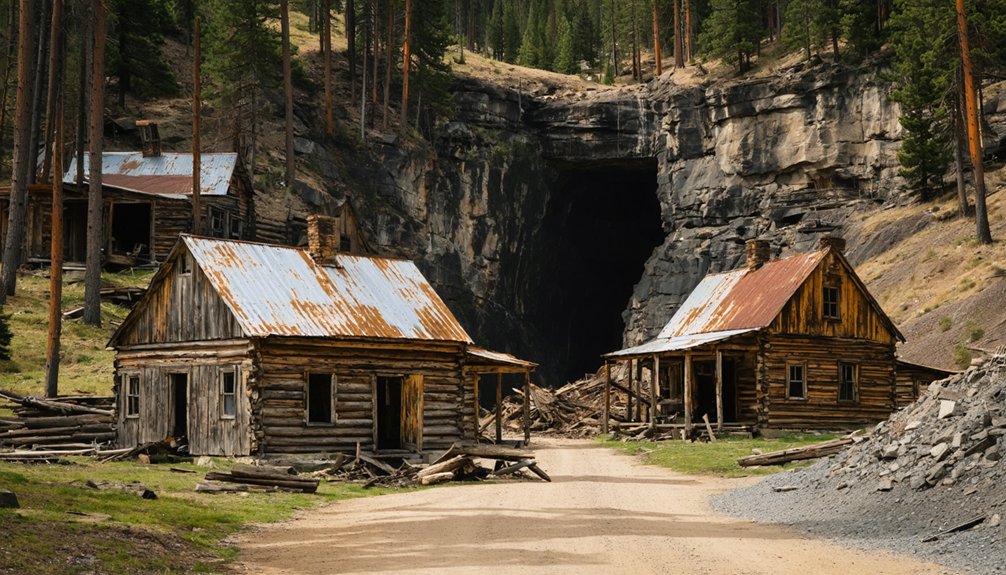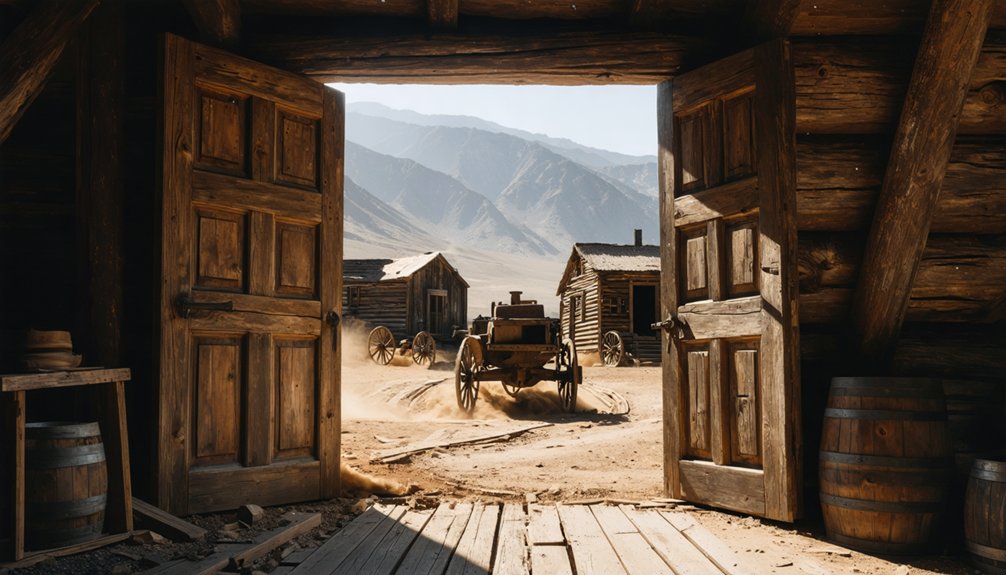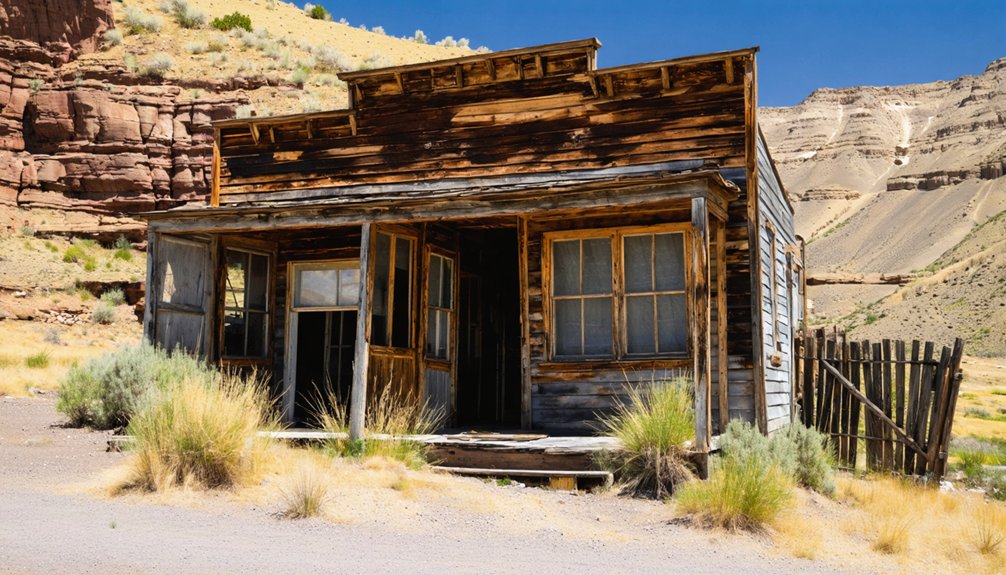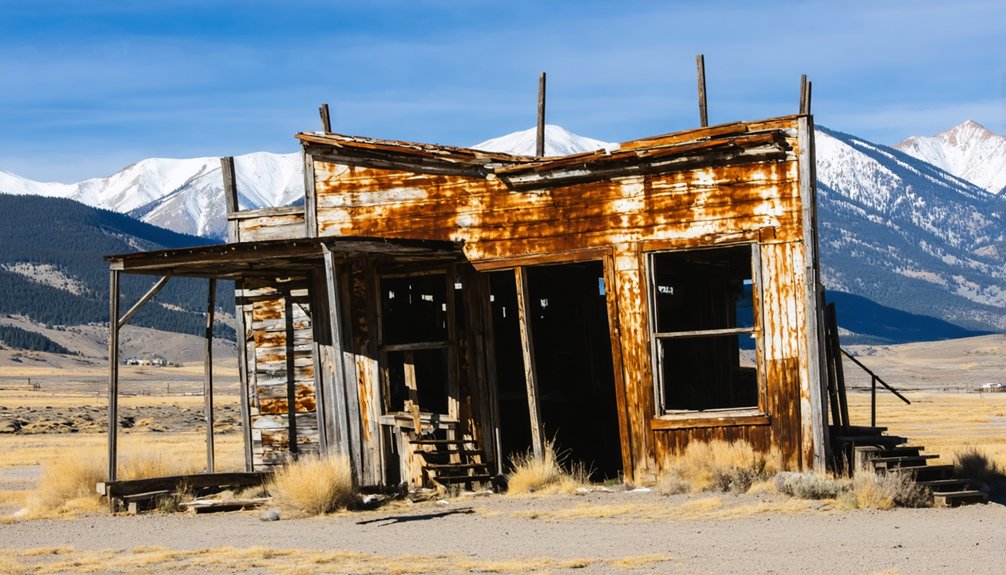You’ll find Shoup, Idaho nestled along the Salmon River, where gold fever transformed a rugged canyon into a bustling mining town. Established in 1881 and named after Idaho’s first governor, George L. Shoup, the town boomed to 600 residents by the 1890s. Today, this remote ghost town houses just 1-4 permanent residents who live off-grid, while seasonal visitors explore its historic mining remnants, including two 10-stamp quartz mills and old log cabins that tell tales of frontier perseverance.
Key Takeaways
- Shoup is a former mining boomtown established in 1881 during Idaho’s gold rush, named after the state’s first governor George L. Shoup.
- The town peaked at 600 residents in the 1890s but declined as gold deposits diminished, now hosting only 1-4 permanent residents.
- Historic remnants include abandoned mining cabins, two 10-stamp quartz mills, and four arastras from its gold mining heyday.
- The town’s extreme isolation in a 5,000-foot deep canyon made transportation difficult, requiring specialized boats and primitive trails.
- Today, Shoup serves as a destination for outdoor enthusiasts, offering historic lodging, whitewater rafting, and gold mining site exploration.
A Mining Town Born in the Gold Rush
During Idaho’s vibrant mining boom, the town of Shoup emerged in 1881 as a promising settlement along the Salmon River’s rugged banks.
You’ll find its historical significance deeply rooted in the gold mining operations that drew prospectors to this remote location. Named after Idaho’s first governor, George L. Shoup, this frontier town quickly grew to accommodate nearly 600 residents at its peak.
The discovery of gold by Ben Harrison in 1882 brought even more miners to the area. The settlement’s story began even earlier, with placer gold mining activities starting in 1868-1869. Samuel James and O’Hara made a major lode discovery that accelerated the town’s development in late 1881. As word spread of the area’s rich mineral deposits, prospectors flocked to the Mineral Hill District, establishing over 300 claims by the 1890s.
The town’s economy thrived on these mining operations, with notable mines like Clipper-Bullion and Gold Hill leading the way in precious metal production.
Life in the Canyon: From Boom to Ghost
While Shoup once bustled with the energy of 600 gold-seeking residents, by the 1980s you’d find just a lone store and scattered cabins along the Salmon River’s rugged banks.
The canyon isolation shaped a self-reliant lifestyle where you’d pump gas using gravity-flow systems and trek 17 miles to North Fork for mail three times weekly. You couldn’t count on electricity, and newspapers from Missoula had to travel 140 mountainous miles to reach you.
Life centered around the store, where you’d pick up essentials like fishing tackle, worms, and homemade baked goods. Don and Donna Myers kept the store’s shelves stocked with pickled eggs and pies.
The steep terrain and tributary canyons that once sheltered Mountain Shoshone now created a haven for those seeking distance from modern conveniences, preserving a rare glimpse into America’s frontier spirit. Named after Colonel George L. Shoup, Idaho’s first state governor, the town’s legacy endures in the rugged landscape.
The Rise and Fall of Shoup’s Population
If you’d visited Shoup during its 1890s mining peak, you’d have found yourself among 600 residents, including diverse groups of miners, merchants, and their families working the district’s 300-plus claims.
Like many boom-bust mining towns in Idaho, Shoup’s fortunes were tied to the success of its mineral extraction activities.
The town’s dependence on mining proved unsustainable as gold deposits diminished in the early 1900s, leading to a stark population decline that left only two permanent residents by the 1980s.
Today, you’ll find a small community of 4 to 25 people, primarily serving outdoor enthusiasts who visit this historic mining settlement for recreation in Idaho’s rugged Salmon River country. Visitors can explore the town’s rich history through its old log schoolhouse that has been converted into lodging accommodations.
Mining Boom Draws Thousands
As word of rich mineral deposits spread throughout Idaho Territory in the late 1880s, Shoup rapidly transformed from a remote wilderness outpost into a bustling mining town.
You’ll find that prospectors like Robert N. Bell and Sam James struck it rich in 1886, followed by George Hearst’s discoveries in 1888. The town’s mining infrastructure expanded quickly to include two 10-stamp quartz mills and four arastras, with the Kentuck mill leading economic sustainability by producing $7,200 monthly in 1889.
- Hundreds of mineral lodes were discovered, attracting waves of enthusiastic miners
- The town developed sophisticated amenities including an opera house and art gallery
- Two major quartz mills and four arastras supported large-scale mining operations
- Hotels, saloons, and boarding houses sprung up to serve the growing population
- The Kentuck water-powered mill became a cornerstone of local industry
Ghost Town Era Begins
Despite the initial prosperity of Shoup’s mining heyday, the town’s population began a steady decline in the early 1900s.
You’ll find that several factors contributed to Shoup’s transformation into a ghost town. The remote location along the Salmon River canyon, coupled with limited access to modern amenities and electricity, made life increasingly challenging for residents. The closure of the post office and school marked significant turning points in the town’s ghost town history.
As mining operations dwindled, particularly at the once-prosperous Clipper-Bullion Mine, families gradually moved away. The area eventually became a popular fishing resort destination.
Today, you can explore Shoup’s mining heritage through the remaining historic cabins and mill structures, though they’re weathered by time. While the town’s permanent population has virtually disappeared, the area now draws visitors seeking river adventures and glimpses of Idaho’s rugged past.
Modern-Day Handful Remains
While Shoup once bustled with gold-seeking prospectors in the 1880s, today you’ll find only 1-4 permanent residents calling this remote Idaho settlement home.
Modern survival in Shoup requires self-sufficiency, as there are no operating stores or public services. The handful of inhabitants live off-grid in historic cabins, preserving a lifestyle that echoes the town’s frontier past. Similar to other remote Idaho communities, residents rely on wood stove heating to endure the harsh winters. Dan provides essential services as the town’s resident caretaker, managing cabins and meals for visitors.
Seasonal visitors now outnumber permanent residents, with adventure seekers drawn to the rugged Salmon River canyon.
- Historic log cabins and a repurposed schoolhouse offer basic lodging for fishermen and rafters
- Rough dirt roads provide the main access to this isolated community
- Original mining equipment and mill remnants dot the landscape
- The town serves primarily as a stopover for outdoor enthusiasts
- Residents maintain a traditional frontier lifestyle without modern conveniences
Along the River of No Return

As you travel along Idaho’s Salmon River, you’ll find Shoup nestled in a remote canyon where early settlers braved the “River of No Return” to establish their mining claims.
The challenging terrain forced residents to rely heavily on river transport, with supplies and equipment moving upstream via specially designed boats that could navigate the dangerous waters.
The town’s position along this historic waterway shaped both its culture and its challenges, as the river served as both a lifeline for the community and a formidable barrier that contributed to its isolation.
Historic Salmon River Culture
Long before European settlers arrived, the Salmon River region teemed with indigenous cultures, primarily the Nez Perce who inhabited the area for over 8,000 years. This rich Indigenous heritage included vast networks of permanent villages, specialized fishing techniques, and sacred ceremonies honoring the salmon’s return. The tribes considered the river sacred for survival due to its abundant resources.
You’ll find the cultural significance of salmon deeply woven into the spiritual fabric of the tribes who called this wild river home.
- Nez Perce maintained over 100 permanent villages across Idaho and Montana by 1800
- Multiple tribes, including Shoshone, Bannock, and Paiute, gathered for trade at Council Valley
- First-salmon ceremonies celebrated the fish’s return and guaranteed future abundance
- Traditional fishing methods used specialized nets and traps at established fisheries
- The Salmon River supported diverse protein sources including deer, elk, and waterfowl
Remote Canyon Transportation
Before motorized boats transformed river traversal in 1947, transportation through Idaho’s remote Salmon River Canyon relied primarily on one-way scow boats, packhorses, and primitive trail networks.
The rugged terrain, with its 5,000-foot deep canyon stretching nearly 200 miles, made traditional road and rail construction virtually impossible between Salmon and Riggins.
You’ll find that canyon access dramatically improved when Glen Wooldridge pioneered upstream travel with his 22-foot plywood boat powered by a 33-hp outboard engine.
Before this breakthrough, packers like James B. “Captain” Ellis were essential for supplying isolated settlements like Shoup, maneuvering steep mountain trails with pack strings.
The Pacific and Idaho Northern Railroad’s attempts to forge routes through Little Salmon Canyon failed, leaving remote transportation dependent on resourceful alternatives until jet boats later revolutionized river travel.
River Access Settlement Challenges
While the River of No Return earned its name from the impossibility of upstream navigation, settling along its banks proved equally challenging for early pioneers.
You’ll find that settlement barriers went beyond just the fierce currents – the rugged terrain and remote location posed significant obstacles for those seeking to build communities like Shoup along these wild waters.
- River navigation required specially designed flat-bottomed scows, which couldn’t return upstream.
- Continuous bends and dangerous rapids made crossing points scarce.
- The canyon’s ancient walls, dating back 1.4 billion years, limited accessible building sites.
- Early settlers faced isolation from main supply routes and trading centers.
- Transportation of mining equipment and basic supplies demanded innovative solutions, often resulting in boats being dismantled for lumber after one-way journeys downstream.
Mining Legacy and Historic Buildings

As gold fever swept through Idaho Territory in 1881, the mining town of Shoup emerged along the Salmon River, named after territorial governor George L. Shoup.
The town quickly grew as miners employed various mining techniques, from placer mining in river gravels to underground lode mining in mountainside tunnels. You’ll find evidence of this rich history in the remnants of two 10-stamp quartz mills and four arastras that once processed valuable ore.
From river gravels to mountain tunnels, miners left their mark through abandoned mills and arastras that once processed Shoup’s precious metals.
The community infrastructure supported over 600 residents at its peak, with boarding houses, stores, and a schoolhouse.
Today, you can still see the historic post office established in 1883, while old mining cabins dot the landscape. The former schoolhouse has been repurposed as visitor lodging, preserving a tangible connection to Shoup’s mining heritage.
Daily Life in Remote Idaho Territory
Life in remote Idaho Territory demanded remarkable resilience from its diverse inhabitants. You’d have faced harsh conditions while establishing daily routines in isolated settlements, where basic amenities were scarce. Your cultural practices would’ve been shaped by the mix of English, Chinese, Czech, Dutch, French Canadian, German, Mexican, and Scandinavian influences that converged in mining towns and farming communities.
- You’d rely on general stores, saloons, and boarding houses as essential community hubs.
- Your survival often depended on bartering goods when cash was scarce.
- You’d need to prepare for brutal winters with limited access to fresh food.
- Basic healthcare was rare, requiring self-reliance during illness or injury.
- Your communication with the outside world was limited until telegraph and telephone services arrived in the 1860s-80s.
Preserving the Past: What Remains Today

Standing as a tribute to Idaho’s mining heritage, Shoup retains several original structures that offer glimpses into its frontier past.
You’ll find the historic log schoolhouse repurposed as visitor lodging, while scattered mining cabins dot the Salmon River canyon. These preserved buildings serve modern-day adventurers seeking wilderness experiences.
While historic preservation efforts remain largely informal, you can explore mining relics and equipment that still mark the landscape.
The town’s minimal population of just a few residents helps maintain its authentic ghost town character.
Though you won’t find traditional services or stores, the remaining structures provide basic accommodations for fishermen, rafters, and hunters.
Tourism impact stays naturally limited due to rough dirt roads and the remote setting, helping protect this living piece of Idaho’s frontier history.
Adventure Tourism in a Ghost Town Setting
Three major adventure activities draw visitors to Shoup’s rugged wilderness setting: fishing the renowned Salmon River, steering through whitewater rapids, and exploring historic mining sites.
You’ll find yourself in a true wilderness experience, where limited cell service and basic amenities create an authentic frontier atmosphere. The town’s remote location, accessed by winding mountain roads, sets the stage for genuine ghost town exploration and outdoor adventures.
Step into raw wilderness where modern comforts fade away, leaving you to discover untamed landscapes and forgotten places.
- Stay in historic cabins or the restored log schoolhouse while planning your excursions
- Join guided river trips that combine rafting thrills with gold mining history
- Try your luck at gold panning along the riverbanks near abandoned mines
- Photograph wildlife and rugged canyon landscapes in the surrounding national forest
- Navigate off-road trails to discover mining equipment remnants and historic mills
Notable Figures Who Shaped Shoup
While adventurous travelers explore Shoup’s wilderness today, the town’s rich legacy began with remarkable individuals who shaped its development. At the forefront stands George L. Shoup, the town’s namesake and Idaho’s last territorial governor. You’ll find his influence woven into the fabric of Shoup history, from his humble beginnings in Pennsylvania to his rise as a Civil War colonel and eventual U.S. Senator.
Independent prospectors laid the groundwork for Shoup’s establishment in 1868, braving harsh conditions to discover the area’s gold potential. Their determination paid off in 1881 when significant lode discoveries transformed the canyon into a bustling community of 10,000 residents.
Through Shoup’s leadership and the prospectors’ grit, this mining town became a symbol of the pioneering spirit that defined Idaho’s territorial expansion.
Frequently Asked Questions
What Wild Animals Were Commonly Encountered by Early Shoup Settlers?
You’d find wildlife encounters with bison, mountain sheep, elk, and deer, while facing predator threats from grizzlies, wolves, and mountain lions. Fish like salmon were abundant year-round.
How Did Residents Get Medical Care in Such a Remote Location?
Necessity is the mother of invention – you’d rely on neighbors’ help, home remedies from local plants, and self-care knowledge passed down through generations. Without telemedicine options, reaching Missoula’s hospital meant grueling mountain journeys.
What Was the Average Temperature and Weather Conditions in Shoup?
You’d experience an average climate of 46.65°F, with dramatic seasonal changes from winter lows around 16°F to summer highs reaching 91°F, plus about 15 inches of yearly precipitation.
Did Any Famous Outlaws or Bandits Ever Hide in Shoup?
Despite 100+ years of local lore, you won’t find records of famous outlaws using Shoup as a hideout. While its remote location was perfect for bandits, no documented cases exist.
How Did Children Receive Education Before the Schoolhouse Was Built?
You’d learn from your parents, neighbors, and religious leaders through homeschooling methods and community learning. Older children often taught younger ones, while practical skills and storytelling formed the educational foundation.
References
- https://www.visitsalmonvalley.com/historic-adventures/ghost-towns/
- https://www.idahomagazine.com/article/shoup-spotlight-city-idaho/
- https://idahodocs.contentdm.oclc.org/digital/api/collection/p16293coll3/id/5503/download
- https://www.youtube.com/watch?v=elltklkfmi0
- https://history.idaho.gov/wp-content/uploads/2018/08/0064.pdf
- https://hicksfamilyhistory.com/2025/05/06/shoup-idaho-a-lonely-outpost-along-the-salmon-river/
- https://www.lemhicountyidaho.org/about-lemhi-county
- https://history.idaho.gov/wp-content/uploads/2018/08/0009.pdf
- https://westernmininghistory.com/library/113/page1/
- https://www.idahogeology.org/pub/Bulletins/B-22.pdf



